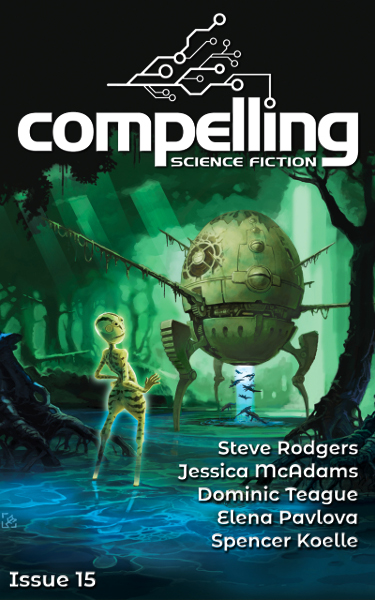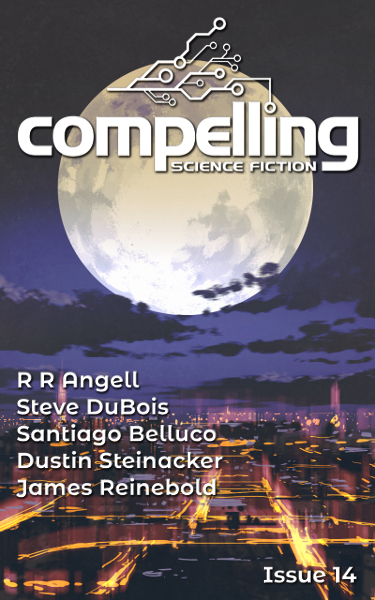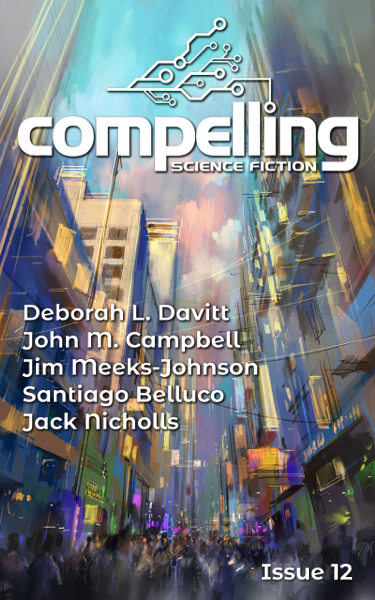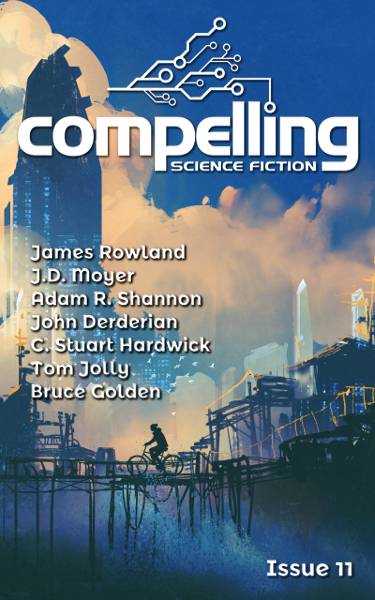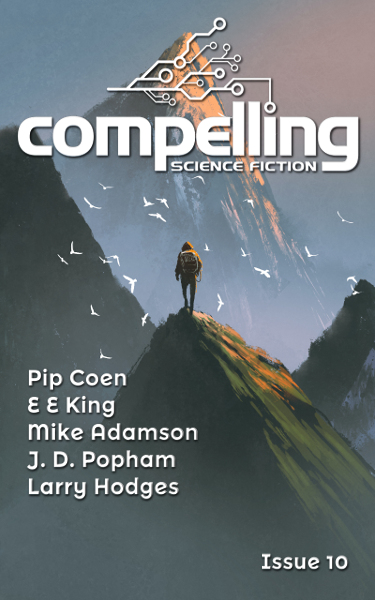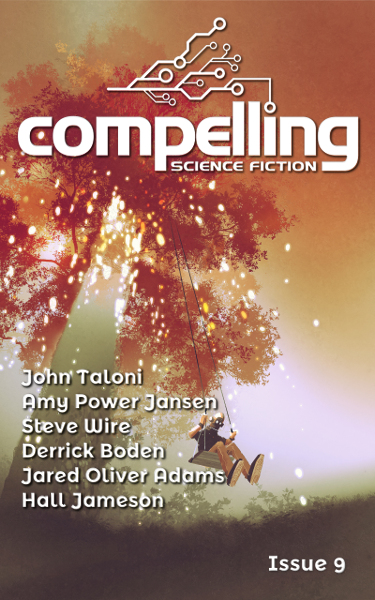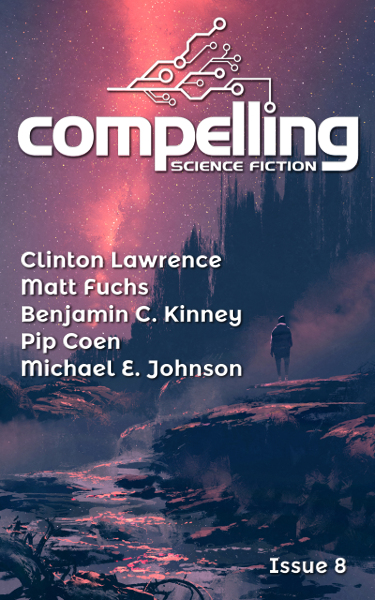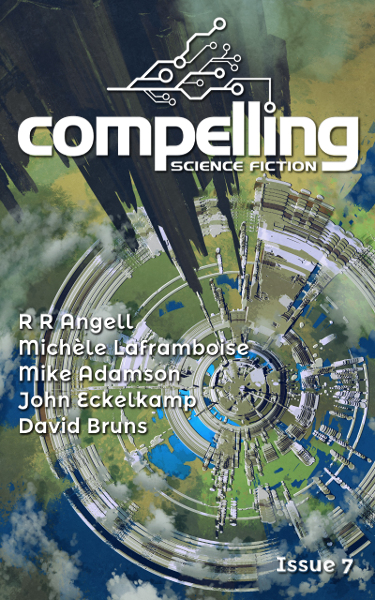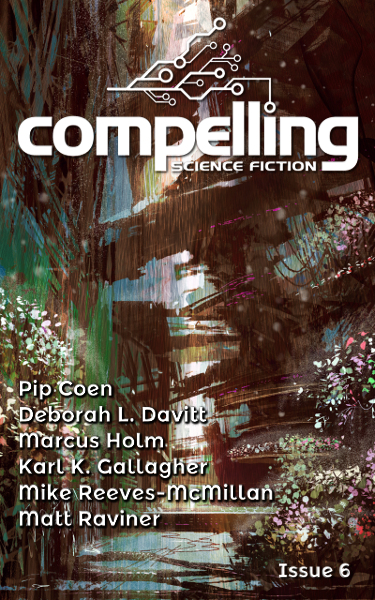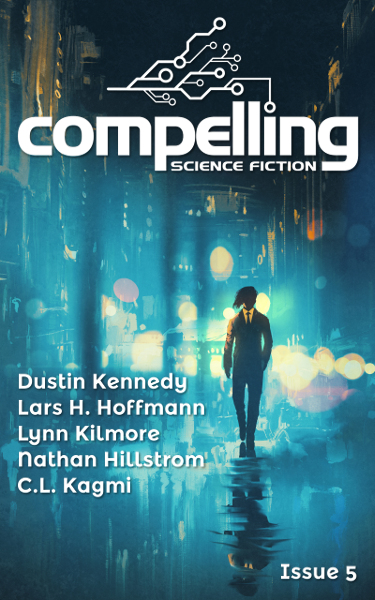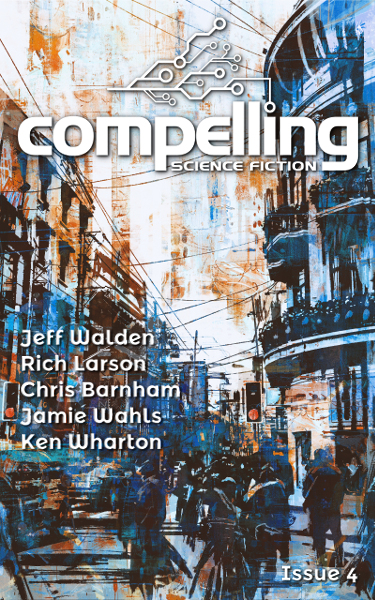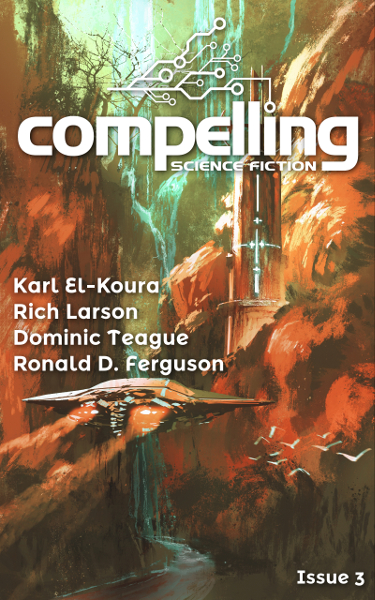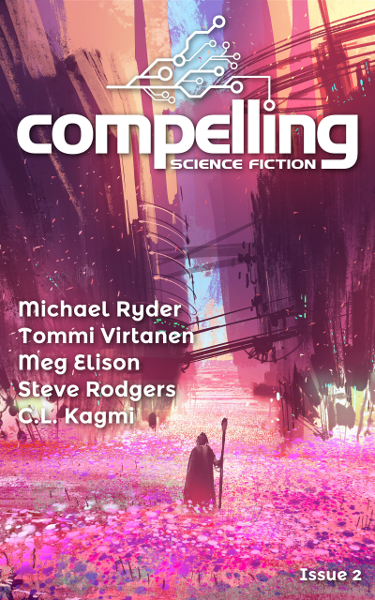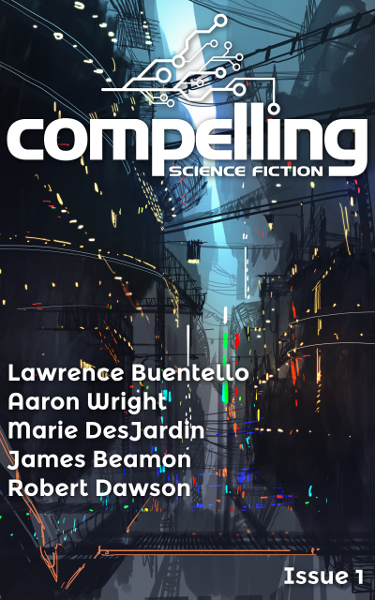Compelling Science Fiction Issue 15
May 2020
This issue was created in partnership with Flame Tree Press.
We start with Steve Rodgers' "Housefly Tours". Four hundred years in the future, a very special adventure tour takes tourists to spy on the only other sentient race ever discovered. But human mistakes and frailty may just ruin everything (9461 words). Our second story is "The Stillness of the Stars" by Jessica McAdams. A young woman escapes the lower-class decks of a generation ship only to find that those on the affluent upper decks have been lying about the journey on which they’ve all embarked (5627 words). The third story this issue, Dominic Teague's "Portrait of a Rogue," is a story about an investigative journalist who interviews a wealthy savant concerning his family’s shady history of scientific and artistic innovations (2000 words). Next we have "Two Moons" by Elena Pavlova. This one is a story about a young girl who must survive a coming-of-age trial outside the giant extra-terrestrial organism in which she lives (6500 words). The final story is "Drought and Blood" by Spencer Koelle. Amelia Okella's life work is threatened by public suspicion when a man is found exsanguinated in a field of her bio-engineered drought-prevention plants (5900 words).
- Housefly Tours
by Steve Rodgers - The Stillness of the Stars
by Jessica McAdams - Portrait of a Rogue
by Dominic Teague - Two Moons
by Elena Pavlova - Drought and Blood
by Spencer Koelle
Compelling Science Fiction Issue 14
Winter 2019
We start with R R Angell's "A Dog's Life". It's about a dog, a family, and cryo-storage (3937 words). Our second story is "Cravings" by Steve DuBois. In a near-future America run according to the standard that the neediest are served first, a policeman confronts the sacrifices that that principle requires (6000 words). The third story this issue, Santiago Belluco's "The Engineering of Alyssa Langley," is a story about a young woman who hires a black-market genetic engineer to reverse the changes her parents illegally foisted on her. But can she really trust him, especially after her modifications turn out to be far different than she expected (5300 words)? Next we have "Envoy in the Ice" by Dustin Steinacker. This one is a story about humanity's yearly diplomatic visit to a mercurial alien entity who has set up in the Antarctic. It is a reprint that originally appeared in Writers of the Future Vol. 33 (8700 words). The final story is "Our 500-Year Plan" by James Reinebold. Noboru, a digitized drone control operative on a space ark, attempts to maintain control over his life as his environment begins to lose its fidelity (2500 words).
- A Dog's Life
by R R Angell - Cravings
by Steve DuBois - The Engineering of Alyssa Langley
by Santiago Belluco - Envoy in the Ice
by Dustin Steinacker - Our 500-Year Plan
by James Reinebold
Compelling Science Fiction Issue 13
Summer 2019
We start with LA Staley's "Steps in the Other Room". An elderly woman reports that her husband has been kidnapped. This seems difficult, since he has been dead for many years (2040 words). Our second story is "Sasha Red" by Tyler A. Young. In it, a woman fights to rescue refugees from Mars (6100 words). The third story this issue, Mark Parlette-Cariño's "Bodybit," is a story about the social effects of a fitness device that tracks sexual performance (4630 words). Next we have "What We Remember" by Mark Salzwedel. This one is first-contact story about a telepathic fungus (2800 words). Our fifth story is "Love and Brooding" by M. J. Pettit. Inspired by mouth-brooding tilapia, this story explores a very alien life cycle (5000 words). Our final story is "Steadies" by returning author Robert Dawson. A doctor is conflicted when she decides to prescribe her husband an anti-cholesterol drug that has also recently been found to strengthen relationships (3400 words).
- Steps in the Other Room
by LA Staley - Sasha Red
by Tyler A. Young - Bodybit
by Mark Parlette-Cariño - What We Remember
by Mark Salzwedel - Love and Brooding
by M. J. Pettit - Steadies
by Robert Dawson
Compelling Science Fiction Issue 12
Winter 2018
Now we're back with another 5-story issue! This issue starts with Deborah L. Davitt's "The Lonely Dark". Under a mountain of crushing debt, an asteroid miner faces hardships he never anticipated (5950 words). Our second story is "False Identity" by John M. Campbell. In it, a detective has to deal with a suspect who performs brain surgery to alter behavior (6000 words). The third story this issue, Jim Meeks-Johnson's "The Mojo Economy," is a story about devices brought by aliens to humanity. These devices can make life easier for everyone, and the aliens only ask that each human use their device to fulfill a few assigned jobs every day. How will society change as a result? (3700 words). Next we have "The Forest Eats" by Santiago Belluco. This one is about a man who goes searching for a disease cure in a biological waste dump. He finds more than he bargained for. (6100 words). Our fifth and final story is "Utility" by Jack Nicholls. In a far future post-scarcity society, individual utility is judged very differently. When a hero astronaut returns to earth, he will need the help of a reluctant local to adjust (4300 words).
- The Lonely Dark
by Deborah L. Davitt - False Identity
by John M. Campbell - The Mojo Economy
by Jim Meeks-Johnson - The Forest Eats
by Santiago Belluco - Utility
by Jack Nicholls
Compelling Science Fiction Issue 11
Summer 2018
This issue starts with James Rowland's "Top of Show", a metastory about the art of creating stories (5948 words). Our second story is "Targeted Behavior" by J.D. Moyer. In it, someone wants the homeless to leave San Francisco. A young girl has other ideas. (4600 words). The third story this issue, Adam R. Shannon's "Redaction," is a story about medics who use technology to deal (or not deal) with their own traumatic experiences (4953 words). Next we have "Cold Draft" by John Derderian. This is a short one about how a radical politically motivated law surprises a teenage boy (2900 words). Our fifth story is "Dreams of the Rocket Man" by C. Stuart Hardwick. This is a beautiful reprinted story about a child learning rocketry from an enthusiastic mentor (7600 words). Story number six, "Driving Force" by Tom Jolly, is the shortest of the lot. In the future, AIs may not only be tasked with driving (1300 words). Our final story is "Don't Play the Blues", by Bruce Golden. A musician wrestles with experiences from his military days (6040 words).
- Top of Show
by James Rowland - Targeted Behavior
by J.D. Moyer - Redaction
by Adam R. Shannon - Cold Draft
by John Derderian - Dreams of the Rocket Man
by C. Stuart Hardwick - Driving Force
by Tom Jolly - Don't Play the Blues
by Bruce Golden
Compelling Science Fiction Issue 10
Winter 2017
This month we have a fantastic issue with mostly longer reads, starting with Pip Coen's story "Inside-of-Body Experience". The story is a unique take on sharing a body with an intelligent alien parasite (7176 words). Our second story is the shortest of the bunch, "The Virgin of Santos de la Tierra" by E E King. The tale is about human behavior and the spread of a fungal pathogen (1725 words). The third story this issue, Mike Adamson's "Hostile Intent," is a near-future corporate drama centering around an asteroid mining company (8009 words). Next we have "Museum Piece" by J. D. Popham. This one is a fun action adventure about a robot that breaks out of his museum exhibit on Mars (6000 words). Our final story is "Redo" by Larry Hodges. The story follows an alien census taker who spends 83,000 years taking a worldwide human census – and he’s only halfway through (6300 words).
- Inside-of-Body Experience
by Pip Coen - The Virgin of Santos de la Tierra
by E E King - Hostile Intent
by Mike Adamson - Museum Piece
by J. D. Popham - Redo
by Larry Hodges
Compelling Science Fiction Issue 9
October/November 2017
This month we have a long six-story issue jam-packed with interesting concepts! John Taloni's story "Fermi's Last Survivor" is a possible explanation for the Fermi Paradox (3850 words). Our second story, "The Fare to Ride the Universe" by Amy Power Jansen, has the most fantasy-flavor of anything we've ever published. It's a tale of introspection (7450 words). The third story in our line-up, Steve Wire's "Catallactics on an Asteroid," is about mining asteroids and artificial intelligence (5333 words). Next we have "Wait Calculation" by Derrick Boden. This one is about members of a generation ship that question their mission (4800 words). Our fifth story is "Urban Fanfare" by Jared Oliver Adams. This near-future story follows a young man who helps his politician mother with an event, in ways he never intended (7200 words). Our final story is "Sounds of the New World" by Hall Jameson, a story about overcoming disabilities in a post-apocalyptic scenario (3500 words).
- Fermi's Last Survivor
by John Taloni - The Fare to Ride the Universe
by Amy Power Jansen - Catallactics on an Asteroid
by Steve Wire - Wait Calculation
by Derrick Boden - Urban Fanfare
by Jared Oliver Adams - Sounds of the New World
by Hall Jameson
Compelling Science Fiction Issue 8
August/September 2017
I'm happy to present another five compelling stories by some fantastic authors! Our first story this time around—"Emerging from the Shadows" by Clinton Lawrence—is a fun adventure that follows two young women who grew up on an asteroid colony founded by a hijacked colony ship 60 years prior. The women find their world disrupted when the colony has its first encounter with a ship from earth. (8800 words). The second story in our line-up, Matt Fuchs' "National Mission System," is a fascinating look at an AI that was created for the express purpose of overhauling the constitution of the United States (4840 words). Our third story, "The Setting of the Sun" by Benjamin C. Kinney, is a short, beautiful tale about a complex machine swarm designed to harvest energy from stars (1300 words). Next we have "Paint by Numbers," another poignant piece by Pip Coen. This one is about a young woman who works for a military program after she demonstrates tremendous genius at "composing" space fleet battle simulations (2010 words). Our final story is "The Dirt Dances" by Michael E. Johnson. The story is about a new kind of hard labor that an old man teaches his young protégé (2300 words).
- Emerging from the Shadows
by Clinton Lawrence - National Mission System
by Matt Fuchs - The Setting of the Sun
by Benjamin C. Kinney - Paint by Numbers
by Pip Coen - The Dirt Dances
by Michael E. Johnson
Compelling Science Fiction Issue 7
June/July 2017
I'm proud to present another five compelling stories by some amazing authors! The issue begins with the lengthily-titled "What's a Few Years When You Get Money and Friends in High Places?" by R R Angell, a story about a bodybuilder who is offered a large sum of money to swap his body with a wealthy man (via head transplant). I was pleasantly surprised at the positive vibe the story manages to convey despite the trials of the protagonist (8400 words). The second story in our line-up, Michèle Laframboise's "Thinking Inside the Box," is an outlandish story about an alien race that requires constant environmental change in order to maintain psychological health (6400 words). Our third story, "Cogito Ergo Sum" by Mike Adamson, focuses on a conversation with an android about what it means to be human. It's a well-known theme in science fiction, but I thought this story was executed particularly well (6950 words). Next we have "Integration" by John Eckelkamp, a very short story about a nascent AI getting its first taste of elementary school (1800 words). Our final story is an underwater tale, "Fathom the Ocean, Deep and Still" by David Bruns. The story is about a living bio-engineered city (6020 words).
- What's a Few Years When You Get Money and Friends in High Places?
by R R Angell - Thinking Inside the Box
by Michèle Laframboise - Cogito Ergo Sum
by Mike Adamson - Integration
by John Eckelkamp - Fathom the Ocean, Deep and Still
by David Bruns
Compelling Science Fiction Issue 6
April/May 2017
I'm proud to present a record six compelling stories for your entertainment! I've never seen quite this level of enthusiasm surrounding a group of stories from our volunteer advisers. I'm also happy to say that fully half of these stories are debuts by new authors — thanks for supporting them! The issue begins with "Floaters Can't Float", an impressive debut story by Pip Coen. An unexpected artifact of time travel causes a zone of New York to become unlivable, and an old archiver guides a reporter through the zone. This is one of those stories that is difficult to capture with a brief synopsis, but it is both poignant and novel (6400 words). The second story in our line-up, Deborah L. Davitt's "Demeter's Regard," is a moving story about a generation ship and the deep relationship that springs up between the ship AI and a man born several generations into the voyage. (5000 words). Our third story (another debut), "Quantum Coursework" by Marcus Holm, is a very fun, technical story about a recursive universe simulation. It's a story that is hard to hold in your head but entertaining to discuss (2889 words)! Next we have "Samaritan" by Karl K. Gallagher, a coming of age story about a boy raised on an Amish-like moon colony. It's a feel-good journey of personal discovery (5600 words). Our fifth story is a near-future tale, "Aspiration Value" by Mike Reeves-McMillan. The story follows a social media model as she navigates a world where her livelihood depends on maintaining a polished veneer in nearly every aspect of her life (2900 words). In our final story, Matt Raviner has crafted a quick, interesting time travel debut in the form of "The Meta Traveler." It's a short work about a brilliant and power-hungry would-be despot who uses time travel as a weapon (1959 words).
- Floaters Can't Float
by Pip Coen - Demeter's Regard
by Deborah L. Davitt - Quantum Coursework
by Marcus Holm - Samaritan
by Karl K. Gallagher - Aspiration Value
by Mike Reeves-McMillan - The Meta Traveler
by Matt Raviner
Compelling Science Fiction Issue 5
February/March 2017
I'm happy to present another five compelling stories for your entertainment! This issue is on the longer side, coming in at a total of 32500 words. The issue begins with "Tav" by Dustin Kennedy, a complex near-future story about an augmented reality company, and about how a man reacts to a secret entrusted to him by his long-time friend and business partner. This knowledge becomes a test of his very sense of self (9250 words). The second story in our line-up, "Entangled," (by Lars H. Hoffmann) is set in space, where a single man is on an incredible mission of discovery (5800 words). Our third story, "X and Y" by Lynn Kilmore, explores how society copes when a madman creates a virus that targets women (5930 words). Next we have "White Dust" by Nathan Hillstrom, a story exploring the concept of self when humans can be easily copied and sent over large distances (5800 words). In our final story, C.L. Kagmi is back with "Skychildren," an exciting tale about a secret commune in the asteroid belt full of illegally genetically engineered humans.
- Tav
by Dustin Kennedy - Entangled
by Lars H. Hoffmann - X and Y
by Lynn Kilmore - White Dust
by Nathan Hillstrom - Skychildren
by C.L. Kagmi
Compelling Science Fiction Issue 4
December/January 2016/2017
I'm very proud to present another five compelling stories for your entertainment. The issue begins with "They Breed Like Flies" by Jeff Walden, a fun, detailed look at the social behaviors of an alien society. The story focuses on a creature at the edge of adulthood as he navigates his own cultural institutions and encounters a human first contact party (8000 words). The second story in our line-up is darker than we normally publish; Rich Larson's "We Are Destroyers" is a story about an AI-controlled commune that is attacked by religious fanatics (2700 words). Our third story is also an AI story: "All That Is Solid" by Chris Barnham. The story is about an emergent empathetic AI that is dismantled out of concern over potential repercussions (4330 words). Next we have "The Little Gods" by Jamie Wahls, a story about what it's like for parents to watch their enhanced child become vastly more intelligent and capable than them. It's a nice short story with a nice ending (1700 words). Our last story, "Down and Out" by Ken Wharton, is a fascinating piece of world-building. The narrative revolves around members of an alien water-dwelling species as they make incredible discoveries about their world (6600 words). "Down and Out" is excerpted with permission from Science Fiction by Scientists: An Anthology of Short Stories published by Springer Science + Business Media.
- They Breed Like Flies
by Jeff Walden - We Are Destroyers
by Rich Larson - All That Is Solid
by Chris Barnham - The Little Gods
by Jamie Wahls - Down and Out
by Ken Wharton
Compelling Science Fiction Issue 3
August/September 2016
I'm ecstatic to present another four amazing stories for your entertainment. The issue begins with "the Undertow Jackpot" by Karl El-Koura. You really don't want spoilers for this one, so I'll just say that it's a story about parenthood and human nature. The second story in our line-up is a short one, Rich Larson's "TrashureIsland." It's about a positive application of augmented reality. Our third story is one of the best time travel stories I've ever read: "the Law of Diminishing Returns" by Dominic Teague. The story is full of dark humor and smart plot devices. Rounding out issue 3 is the longest story we've published to date, "Intent to Occupy" by Ronald D. Ferguson. "Intent to Occupy" has the feel of golden age science fiction, bringing a wonderful human element to the asteroid belt.
- The Undertow Jackpot
by Karl El-Koura - TrashureIsland
by Rich Larson - The Law of Diminishing Returns
by Dominic Teague - Intent to Occupy
by Ronald D. Ferguson
Compelling Science Fiction Issue 2
June/July 2016
I'm excited to present an incredible line-up of stories in our second issue of Compelling Science Fiction! Our first story, Michael Ryder's "Crinkles," takes place on a space station and witnesses the birth of an emotional AI. We continue this off-world trend with "Seeds of War" by Tommi Virtanen. "Seeds of War" is a short first-contact story from the perspective of the contacted, and that's all I'll say to avoid spoilers. Our third story, "Personal Trainer" by Meg Elison, provides our second unique take on mind transference (see this story from issue 1 for a different kind of mind transference). Next comes the longest story we've ever published, "Oelinium," by Steve Rodgers. "Oelinium" clocks in at around 8000 words, and does the difficult job of introducing a sprawling universe in short-story form. Rounding out this issue is "Twiceborn," by C.L. Kagmi. "Twiceborn" is told from the perspective of an ancient race trying to survive xenocide. I hope you enjoy reading these stories as much as I did!
- Crinkles
by Michael Ryder - Seeds of War
by Tommi Virtanen - Personal Trainer
by Meg Elison - Oelinium
by Steve Rodgers - Twiceborn
by C.L. Kagmi
Compelling Science Fiction Issue 1
April/May 2016
This first issue contains five excellent (dare I say, compelling) stories. We start with Lawrence Buentello's "Gaia's Children," an intense tale about planetary colonization. Our second story, Aaron Wright's "Reflection," gives a glimpse into the life of a sentient hospital. We follow that up with "Mean and Clean" by Marie DesJardin, a lighthearted look at a unique alien life-form. "Opportunities for Lost Children" by James Beamon comes next, giving an interesting take on mind transference. Rounding out our lineup is "the Art of Failure" by Robert Dawson, an exhilarating first contact situation with a clever resolution.
- Gaia's Children
by Lawrence Buentello - Reflection
by Aaron Wright - Mean and Clean
by Marie DesJardin - Opportunities for Lost Children
by James Beamon - The Art of Failure
by Robert Dawson
